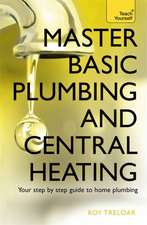Improving Concrete Quality
Autor Karthikeyan H Oblaen Limba Engleză Hardback – 25 iun 2014
Quality measurement is not prevalent in the concrete industry and quality investment is not seen as potentially generating a positive return. Improving Concrete Quality examines how and why concrete quality should be measured, and includes instruction on developing specifications with the aim of improving concrete quality.
Reduce Concrete Variability: Reduce Costs and Increase Volume
The first part of the book considers the tangible and intangible benefits of improved quality. The later chapters explore concrete strength variability in detail. It provides a greater grasp of the variation in concrete, as well as a deeper understanding of how material variability affects concrete performance. The author discusses the components of variability (material, manufacturing, testing) and provides steps to measuring and reducing variability to improve the quality of concrete. The text also contains a chapter on data analysis for quality monitoring and test results.
Come Away with Practices and Tools That Can Be Applied Immediately:
- Provides techniques and how specifications can improve concrete quality
- Offers a clear understanding of the link between the materials (cement, SCM, aggregate, water, air), manufacturing, testing variability, and concrete quality
- Includes information on analyzing test data to improve quality
Preț: 681.88 lei
Preț vechi: 990.41 lei
-31% Nou
Puncte Express: 1023
Preț estimativ în valută:
130.50€ • 135.73$ • 107.73£
130.50€ • 135.73$ • 107.73£
Carte tipărită la comandă
Livrare economică 14-28 aprilie
Preluare comenzi: 021 569.72.76
Specificații
ISBN-13: 9781466592124
ISBN-10: 1466592125
Pagini: 214
Ilustrații: 39 black & white illustrations, 52 black & white tables
Dimensiuni: 156 x 234 x 20 mm
Greutate: 0.52 kg
Ediția:1
Editura: CRC Press
Colecția CRC Press
ISBN-10: 1466592125
Pagini: 214
Ilustrații: 39 black & white illustrations, 52 black & white tables
Dimensiuni: 156 x 234 x 20 mm
Greutate: 0.52 kg
Ediția:1
Editura: CRC Press
Colecția CRC Press
Public țintă
Academic and Professional Practice & DevelopmentCuprins
How Good is Your Quality? Variation in Concrete Strength Due to Cement. Variation in Concrete Strength Due to Water and Air Content Variation. Mixing Water Control. Variation in Concrete Strength and Air Content Due to Fly Ash. Variation in Concrete Performance Due to Aggregates. Basic Statistics. Variation in Concrete Performance Due to Batching. Variation in Concrete Performance Due to Manufacturing. Variation in Concrete Performance Due to Testing. Internal Concrete Testing. Using Jobsite Test Results for Improving Concrete Quality. Impact of Specifications on Concrete Quality. Impact of Concrete Quality on Sustainability. Elements of a Quality Management System for a Concrete Producer.
Recenzii
"Extremely comprehensive and practical… The chapter on basic statistics is a must read to clear the concepts required to understand how to analyse data for monitoring quality. Apart from the process - be it regarding material or testing, the author has also covered capability building and training which forms a core part of the entire business."
—Indian Concrete Journal, December 2014
"Many concrete manufacturers neglect to quantify not only the cost of producing poor quality concrete, but the potential savings in the reduction of cementitious content by focusing on standard deviation and tightening controls, particularly with regards to slump control and moisture contents – this book identifies key areas that manufacturers can focus on to improve and realize these savings."
––Charl Marais, Aggregate Industries
"While there are many books on concrete technology, finding one that focuses strictly on improving concrete quality had been difficult until now. Improving Concrete Quality discusses how to improve performance, reduce time and costs, and lower the environmental footprint of concrete while also resulting in an overall improvement in the quality of concrete construction."
—The Concrete Producer, September 2014
—Indian Concrete Journal, December 2014
"Many concrete manufacturers neglect to quantify not only the cost of producing poor quality concrete, but the potential savings in the reduction of cementitious content by focusing on standard deviation and tightening controls, particularly with regards to slump control and moisture contents – this book identifies key areas that manufacturers can focus on to improve and realize these savings."
––Charl Marais, Aggregate Industries
"While there are many books on concrete technology, finding one that focuses strictly on improving concrete quality had been difficult until now. Improving Concrete Quality discusses how to improve performance, reduce time and costs, and lower the environmental footprint of concrete while also resulting in an overall improvement in the quality of concrete construction."
—The Concrete Producer, September 2014
Notă biografică
Karthik Obla, Ph.D., P.E., FACI, is vice president, technical services, National Ready Mixed Concrete Association (NRMCA). He has over 20 years of experience in concrete materials technology and has interests in quality control/assurance, mixture optimization, specifications, use of recycled materials, durability, and new technology. He is a Fellow of the American Concrete Institute and a winner of ACI’s Young Professional Achievement Award. He has published over 75 technical articles in journals and has presented in several international conferences. He holds a Ph.D. in civil engineering from University of Michigan, Ann Arbor, and is a licensed professional engineer in the state of Maryland. He served as vice-president and president for the ACI San Antonio Chapter. Prior to joining NRMCA, he was technical manager at Boral Material Technologies.
Descriere
This book aids concrete producers in improving the quality of ready mixed concrete. It quantifies the benefits of improved quality in terms of cost savings, increased efficiency and consistency, and sustainability. It shows the relation between concrete quality and concrete strength variability, and discusses the components of variability and how one could methodically relate component changes to variability in concrete strength and other properties. It also recommends specific steps that producers might take to reduce component variability and achieve a more consistent product.









